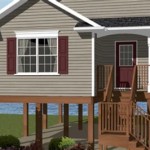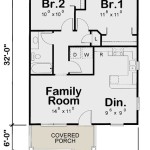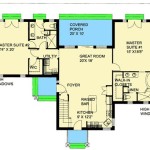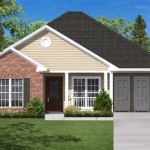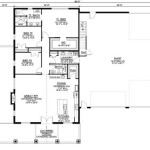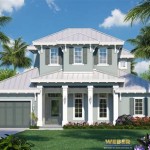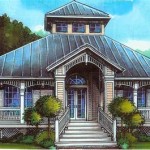House Plans With Covered Porches: Extending Living Spaces Outdoors
House plans incorporating covered porches are a sought-after design feature for homeowners seeking to expand their living space beyond the interior walls. Covered porches offer a versatile area for relaxation, entertainment, and dining, while simultaneously providing protection from the elements. This article will explore the various benefits, design considerations, and styles associated with house plans featuring covered porches, offering a comprehensive understanding of this popular architectural element.
Benefits of Covered Porches
The addition of a covered porch to a house plan provides a multitude of advantages. Firstly, it creates an outdoor living space that can be utilized throughout the year, regardless of the weather conditions. The roof over the porch offers shelter from rain, snow, and intense sunlight, allowing homeowners to enjoy the outdoors even during inclement weather. This extends the usability of the space considerably, transforming it into an extension of the home's interior living area.
Secondly, a covered porch enhances the aesthetic appeal of a home. It adds architectural interest and character to the facade, creating a welcoming and inviting entrance. The porch can be designed to complement the architectural style of the house, further enhancing its curb appeal. From traditional wrap-around porches to modern, minimalist designs, the possibilities are virtually limitless.
Thirdly, a covered porch can increase the value of a property. It is a desirable feature that appeals to a wide range of potential buyers. The added living space, coupled with the enhanced aesthetic appeal, makes a home with a covered porch more attractive and marketable. This is particularly true in regions where outdoor living is highly valued.
Finally, a covered porch provides a transitional space between the indoors and outdoors. It allows for a gradual adjustment to the elements, creating a comfortable buffer zone. This is especially beneficial in areas with extreme temperatures or weather conditions, as it provides a place to acclimatize before fully venturing outside or entering the home.
Design Considerations for Covered Porches
Several key considerations must be taken into account when designing a house plan with a covered porch. The size and shape of the porch should be proportionate to the overall size and style of the house. A small porch on a large house can look out of place, while an overly large porch can overwhelm a smaller dwelling. The design should be aesthetically pleasing and harmonious with the existing architecture.
The orientation of the porch is also crucial. Ideally, the porch should be positioned to take advantage of natural light and prevailing breezes, while also providing shade during the hottest hours of the day. The direction the porch faces will impact the amount of sunlight it receives, which in turn affects its comfort level. Careful consideration of sun angles and wind patterns is essential.
The materials used in the construction of the porch should be durable, weather-resistant, and aesthetically pleasing. Common materials include wood, composite decking, stone, brick, and concrete. The choice of materials will depend on the architectural style of the house, the budget, and the desired level of maintenance. It is important to select materials that complement the existing structure and require minimal upkeep.
Attention should also be paid to the roofing material and style. The roof of the porch should match or complement the roof of the house, ensuring a cohesive and unified appearance. The roof pitch, overhang, and material should be carefully considered to ensure proper drainage and protection from the elements.
Finally, the design should incorporate adequate lighting and ventilation. Lighting is essential for creating a comfortable and inviting atmosphere, especially during the evening hours. Options include recessed lighting, pendant lights, string lights, and sconces. Ventilation is important for maintaining a comfortable temperature and preventing moisture buildup. Fans can be used to circulate air and provide a cooling breeze.
Styles of Covered Porches
Covered porches come in a variety of styles, each offering a unique aesthetic and functionality. The choice of style will depend on the architectural style of the house, the homeowner's personal preferences, and the intended use of the porch.
Traditional Porches: These porches are typically characterized by their classic design elements, such as columns, railings, and a spacious layout. They often feature intricate details and are designed to evoke a sense of timeless elegance. Traditional porches are well-suited for houses with a traditional architectural style, such as Colonial, Victorian, or Craftsman.
Wrap-Around Porches: As the name suggests, wrap-around porches extend around two or more sides of the house. They offer ample outdoor living space and provide panoramic views of the surrounding landscape. Wrap-around porches are particularly popular in rural areas and are often associated with farmhouses and country-style homes.
Screened-In Porches: These porches are enclosed with screens, providing protection from insects and other pests. Screened-in porches are ideal for enjoying the outdoors without the annoyance of bugs. They are often used for dining, relaxing, or entertaining. Screened-in porches can be incorporated into various architectural styles.
Modern Porches: Modern porches are characterized by their clean lines, minimalist design, and use of contemporary materials. They often feature large windows or sliding glass doors that seamlessly connect the indoor and outdoor spaces. Modern porches are well-suited for houses with a modern or contemporary architectural style.
Farmhouse Porches: Farmhouse porches typically feature a simple, rustic design with natural materials like wood and stone. They often have a large swing or rocking chairs and are designed to create a welcoming and comfortable atmosphere. Farmhouse porches are ideal for houses with a farmhouse or country-style aesthetic.
Coastal Porches: Coastal porches are designed to take advantage of the ocean breeze and views. They often feature light-colored materials, such as white wood and pale blue accents. Coastal porches are typically spacious and offer ample seating for enjoying the outdoors. They are well-suited for houses located near the coast.
Materials for Covered Porches
Selecting the right materials for a covered porch is crucial for its durability, aesthetics, and overall performance. Several factors should be considered when choosing materials, including the architectural style of the house, the budget, the climate, and the desired level of maintenance.
Wood: Wood is a classic and versatile material that can be used for a variety of porch elements, including framing, decking, railings, and columns. Wood offers a natural warmth and beauty that is difficult to replicate with other materials. However, wood requires regular maintenance, such as painting or staining, to protect it from the elements. Common types of wood used for porches include cedar, redwood, pressure-treated pine, and mahogany.
Composite Decking: Composite decking is a popular alternative to wood that offers several advantages. It is made from a combination of wood fibers and plastic, which makes it highly durable, weather-resistant, and low-maintenance. Composite decking does not require painting or staining and is resistant to rot, decay, and insect infestation. It is available in a variety of colors and styles to match any architectural style.
Stone and Brick: Stone and brick are durable and aesthetically pleasing materials that can be used for porch columns, foundations, and paving. Stone and brick offer a timeless elegance and can add a touch of sophistication to any porch. They are also relatively low-maintenance and resistant to the elements. However, stone and brick can be more expensive than other materials.
Concrete: Concrete is a versatile and affordable material that can be used for porch flooring, steps, and foundations. Concrete can be stained, stamped, or polished to create a variety of textures and finishes. It is also highly durable and resistant to the elements. However, concrete can be prone to cracking and may require sealing to prevent moisture penetration.
Metal: Metal, such as aluminum or steel, can be used for porch railings, columns, and roofing. Metal is a strong and durable material that is resistant to rust and corrosion. It is also relatively low-maintenance and can be painted to match any color scheme. Metal railings and columns can add a modern or industrial touch to a porch.
Integrating Covered Porches with Indoor Spaces
A well-designed covered porch should seamlessly integrate with the indoor spaces of the house, creating a cohesive and functional living area. This can be achieved through careful planning and design considerations.
Open Floor Plans: Open floor plans can help to blur the lines between the indoor and outdoor spaces. By eliminating walls and partitions between the living room, kitchen, and porch, a more spacious and connected living area can be created. Large windows and sliding glass doors can further enhance the connection between the indoor and outdoor spaces, allowing natural light and views to flow freely.
Matching Flooring: Using the same flooring material on both the porch and the adjacent indoor spaces can create a seamless transition. This can be achieved by using materials such as tile, wood, or concrete that are suitable for both indoor and outdoor use. Alternatively, a similar color or pattern can be used to create a cohesive look.
Consistent Design Elements: Maintaining consistent design elements throughout the indoor and outdoor spaces can help to create a unified and harmonious look. This can be achieved by using similar colors, materials, and architectural details. For example, if the house features a traditional architectural style, the porch should also incorporate traditional elements such as columns, railings, and intricate moldings.
Outdoor Furniture and Accessories: Selecting outdoor furniture and accessories that complement the indoor decor can help to create a cohesive and inviting living space. The furniture should be comfortable, durable, and weather-resistant. Accessories such as rugs, cushions, and lighting can add a touch of personality and style to the porch.
Indoor-Outdoor Kitchens: Consider incorporating an outdoor kitchen into the covered porch design. This can include a grill, sink, countertop, and storage space. An outdoor kitchen allows for seamless entertaining and dining, making the porch a true extension of the indoor living area.
By carefully considering these design elements, a covered porch can be seamlessly integrated with the indoor spaces of the house, creating a functional and inviting living area that can be enjoyed year-round.

Simple House Plans With Porches Wrap Around Porch Small Floor

Your Guide To House Plans With Screened In Porches Houseplans Blog Com

Your Guide To House Plans With Screened In Porches Houseplans Blog Com

Your Guide To House Plans With Screened In Porches Houseplans Blog Com

Wrap Around Porch House Plans For A 4 Bedroom Country Home

3 Bedroom Open Floor Plan With Wraparound Porch And Basement

Minimalist Floor Plans With Porches Houseplans Blog Com

Country Style House Plan With Wrap Around Porch

Cottage Style House Plan Screened Porch By Max Fulbright Designs Plans Lake
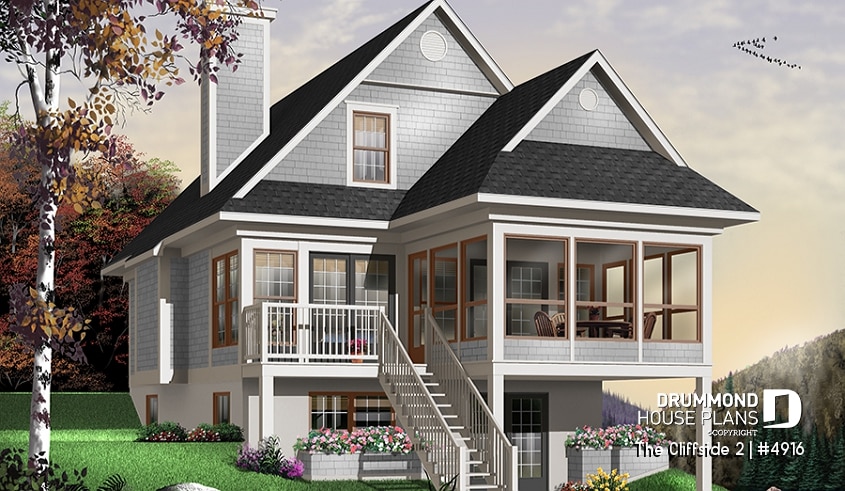
House Plans With Screened Porch Or Sunroom Drummond


